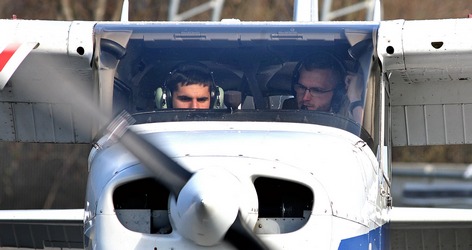Flight Training Q&A
How much does flight training cost?
The fees for flight training are in addition to tuition and fees. The flight training cost can be broken down into sections over four years. Please note that these are estimated cost based on past average flight times required for each rating or license. These average training times are from the FAA data base. Some students may require additional training.
Estimated Non-Tuition Cost for Flight Courses
FAA Knowledge Exams and Practical Tests require an additional fee.
CFII is offered but not a requirement for graduation: $4,880
Where will I be flying?
BSU’s Aviation Training Center is located at the New Bedford Regional Airport, approximately half an hour’s drive from campus. Due to the driving distance between the main BSU campus and the Flight Training Center, all flight students must have their own transportation to New Bedford for flight training.
Bridgewater State University Flight Training Center
New Bedford Regional Airport
1852 Shawmut Ave.
New Bedford, MA 02747
What are the FAA requirements before I can begin flying?
Prior to their first flight lessons all BSU Aviation students must obtain an FAA Medical Certificate. Students will need to make an appointment with an Aviation Medical Examiner (AME) nearest them and fill out an application on MedExpress. In addition to the medical certificate, new students will need to apply for a Student Pilot Certificate by completing an application through the FAA IACRA website and having it certified by a certified flight instructor or FAA representative from the local Flight Standards District Office.
Does BSU coordinate with the Transportation Security Administration (TSA) to provide flight training?
All BSU Aviation students who receive training must comply with current TSA policy and procedures. Compliance requirements depend on citizenship status.
International students should visit the TSA Flight Training Security Program site and create an account. For additional information, visit AOPA's Guide to TSA's Alien Flight Training/Citizenship Validation Rule.
Aircraft Fleet
Cessna 172R Skyhawk
10 aircraft – Non-complex, single-engine aircraft for Private, IR, Commercial, CFI and CFII training
3 aircraft – Non-complex, TAA, Single-engine aircraft
4 seats, Garmin 430W GPS Navigation/Communication Unit
Flight Simulator Lab
BSU Aviation incorporates FAA-approved Two Redbird LD AATD and One Redbird FMX in training course delivery. Located at the Aviation Training Center at New Bedford Regional Airport, the Advanced Aviation Training Device platforms enhances the rapid development of aeronautical decision-making through the use of simulated weather conditions, air traffic control environments, and various flight conditions that would not otherwise be readily available or replicable in the aircraft.
Flight Training Equipment List
The following list represents more than the cost of textbooks for a single semester: It is the start of an investment in your long-term training and your aviation career.
Many of the required FAA publications are available online and free at faa.gov. BSU-specific training for your course of training are available for free download, as well.
Pilots are responsible for familiarizing themselves with the required publications and maintaining the requisite level of knowledge at all times. All students must acquire the following items before their first flight lesson.
Flight Gear
- Flight Bag
- Flight Headset
- E6B Flight Computer (manual)
- VFR Plotter (IFR if conducting Instrument or CFII training)
- View Limiting Device (hood or “foggles”)
- Flashlight (with spare batteries)
- Kneeboard
- Airport/Facility Directory (A/FD)
- Terminal Area Chart (TAC)
- Sectional Chart (New York)
- IFR Low En Route*
- Current Instrument Approach Procedure Charts*
- Flight Logbook
Publications
- BSU Flight Standards Manual (FSM) - Aircraft Specific
- BSU Aviation Operations Manual
- Aircraft Pilot's Operating Handbook
- Applicable FAA Practical Test Standards
- Federal Aviation Regulations (FAR)
- Aeronautical Information Manual (AIM)
- Pilot's Handbook of Aeronautical Knowledge (PHAK)
- FAA Airplane Flying Handbook
- FAA Aviation Weather
- FAA Aviation Weather Services
*(If conducting Instrument or CFII training)
